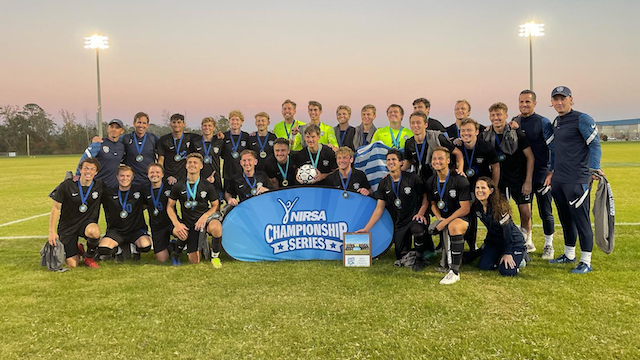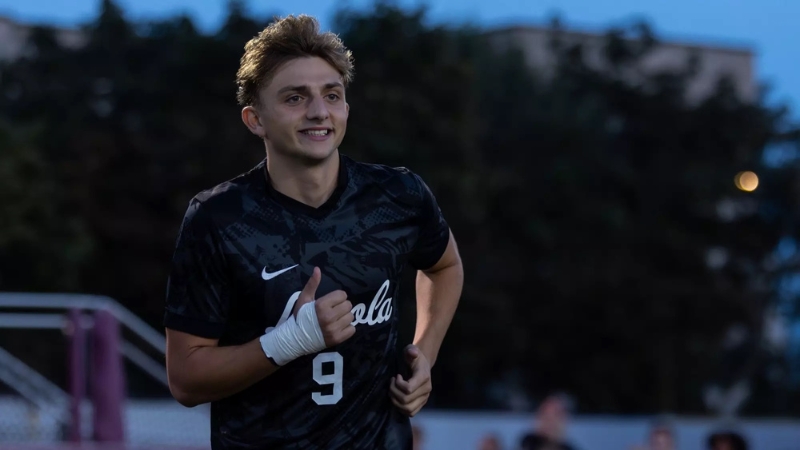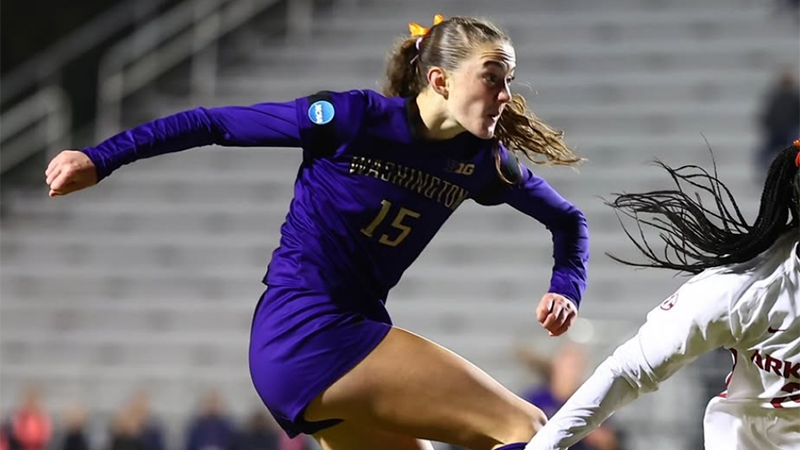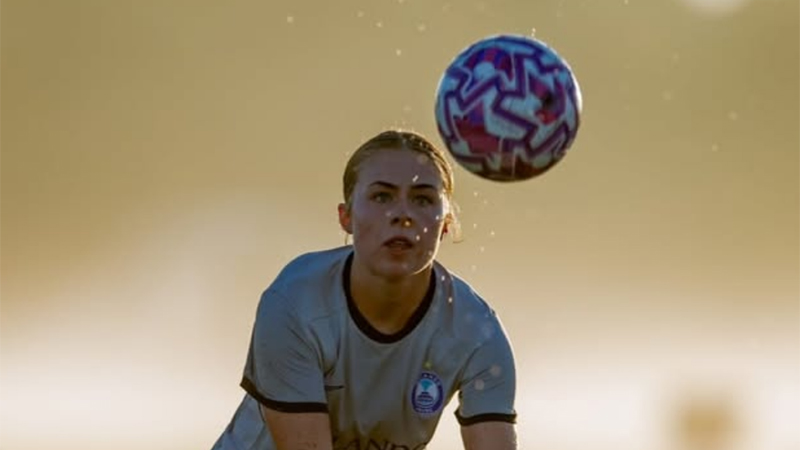BYU’s decades of soccer dominance

Boring is rarely how people describe sports dynasties, but it’s the way former head coach Chris Watkins talked about his BYU teams during the late 90s. The Cougars were so good that they had trouble finding teams to play them.
The legends of the BYU collegiate club men’s soccer team from the late 1990s and early 2000s sound like myths, but the records back up the tall tales. BYU was frankly unbeatable during that time period with a cabinet full of national championships to show for it.
Then the program decided to seek out a higher level of competition and left collegiate club soccer for the USL Premier Development League (PDL). It was an unprecedented jump that drew national and even international attention at the time.
It wasn’t all sunshine and rainbows though. BYU’s promotion to a new league created unforeseen challenges and even had students unaware the school still had a men’s soccer team.
Current head coach Brandon Gilliam was a player on the team during the transition to the PDL and head coach for the move back to college club soccer. He chatted with TopDrawerSoccer this week about BYU soccer, building a successful program, and his ambitions of building awareness for the college club game.
BYU’s dominance at the collegiate club level gained regional and national recognition in mid-1990s with the first National Championships, but the soccer scene at the Provo campus can be traced back to 1955, according to Roy Webb’s book The History of Soccer in Utah.
Carl and Harold Boden, brothers from Germany, noticed that BYU did not have a team and placed an ad in the student paper looking for players. Webb wrote that the school officially recognized the team in 1963, but they were not an NCAA-sanctioned team until the late 1970s.
Lee Benson of the Deseret News wrote about the BYU men’s soccer team and the lack of college soccer in the state of Utah in 1989.
“The BYU program received just under $5,000 in scholarship monies per year, and no budget for recruiting,” Lee Benson wrote for the Deseret News about that NCAA-sanctioned team in the 80s. “The coach during the NCAA years, Jim Dusara, ran something of a loose ship.”
BYU Athletic Director at the time Glen Tuckett was quoted in the piece about the brief, albeit exciting, time for men’s NCAA soccer in Provo.
“The soccer players were always on half-rations," Tuckett told Benson in the piece. "If we could get to the point where we could fund it properly, then OK. But if we're going to do something, we'd like to do it right.”
The men’s team was dropped from NCAA-sanction in the 80s, there is some debate over the exact date. Benson alludes to Dusara’s loose following of NCAA guidelines and the threat of an NCAA investigation as a potential reason while Tuckett firmly points to the lack of funding. The author also highlights some discrepancy over the exact dates that BYU had a NCAA sanctioned men’s soccer team with Tuckett stating it only last four years.
Regardless, BYU men’s soccer never disappeared, rather continued on as a club sport. Following Dusara’s tenure as coach, David Woolley took over the program. He built the foundation for the dynasty from 1987-1995. Chris Watkins, now the head coach of the Gonzaga Division I women’s team, took over the team in 1995 and took it to unimaginable heights with national championship after national championship in the late 90s.
“The Cougars’ winning ways were so well known at the (collegiate) club level, the team had difficulty scheduling matches with other competitive teams” Andrea Ludwig wrote in the BYU Magazine in the Spring 2003 issue.
“Quite frankly, it was boring,” Watkins told the Salt Lake Tribune in 2009. “We knew we were going to win. I felt like we were doing the same thing every year, and I didn't feel that my players were getting as good as they could possibly be.”
Watkins, on the heels of a five NIRSA National Championships in six years, spearheaded the effort to elevate the program to a new frontier for a college soccer team. The BYU club team bought a place in the USL PDL (now called USL League Two) in 2003 for a reported $40,000.
Watkins described the move away from collegiate club soccer to a semi-professional level as an opportunity for the players to see a new challenge after nearly a decade of dominance.
Gilliam, now the BYU head coach, was a star goalkeeper for the team in 2003. He talked about the jump up in level.
“The reason we left collegiate club soccer was for higher level competition without higher costs,” Gilliam said. “To make a team Division I sport, the cost is just so high and athletic departments struggle to make that happen. We were trying to find the best place for the competition. PDL was a great place for that.”
The move up to PDL was not easy. PDL, at the time, had many of the best players from college soccer as well as some players trying to break through to the professional level playing on an all-star squad during the summer.
BYU went 2-15-1 during the first season in the PDL. The Cougars adjusted and grew into an even better team after that learning experience in year one. They enjoyed their best season in 2007 when they were the PDL Northwest Division Champions.
Playing in the PDL had other obstacles for BYU beyond competing against players on the professional pathway. The season was held in the late spring until mid-summer - so college players could have a place to play when school was out of session, but BYU’s campus was mostly empty during that time.
“Most of the kids on campus after five to eight years didn’t even know we had team anymore because they never saw the team,” Gilliam said in relation to the PDL teams being recognized on campus.
The schedule worked against BYU players off-the-field. They did not have the opportunity to take internships in other professions in the summer because that was during the PDL season.
In 2017, BYU left the PDL and returned to the collegiate club level. The decision was years in the making.
“When you have a switch at head coach, a coach who had been there 21 years, it’s very easy to allow things to stay the same way,” Gilliam, who took over as head coach in 2015, said. “Even though I had been there, it was a new dynamic. That was when BYU started looking at all of our programs and seeing where everyone is and what they wanted to do. There was the discussion about what is best for our program and best for the students. We knew it was a discussion point, but we really enjoyed competing in the PDL.”
The coach described that last season in PDL as bittersweet.
“We had a decent season, wasn’t fantastic by any means but we had a good group,” Gilliam said. “We ended up going, not as BYU but our team went to Taiwan to represent USA in the World University games in August right after the PDL season. We played against teams that I’ve never seen teams as good at that level anywhere else.”
Returning to the collegiate club game, BYU fans might have suspected would be a cakewalk, but the local rivals had other ideas.
“There was a very big wake-up call, we played Utah State,” Gilliam added. “It’s a big rivalry game in the football world. They were super pumped. The weather was bad, the field was ok. It ended up being a 1-1 game. For a team coming out of the PDL that played at this level, the guys got a quick wake-up call that no matter how good you are anyone can knock you off at any time. That was a really good game for us. It reset the mindset of coming back to collegiate club. No one is going to hand us anything.”
That opening game result has stuck with the team over the years. The focus on the week-to-week, day-to-day, each training rather than the ultimate goal at the end of the season is the overarching mantra.
“We know the pressure is on us because we have won so many, but if you put the national championship as your only site and you aren’t looking at the day-to-day, you’re probably going to miss out on it.”
BYU won the NIRSA National Championship in 2017, 2019, and 2021. The event was not held in 2020 due to the pandemic. When asked about the continuous success of the BYU program, Gilliam spoke predominantly about the peripherals of the program - those that were not directly tied to the on-the-field product.
“It’s a number of smaller pieces,” Gilliam said about the continual success of the program. “The bigger piece is the desire people have to want to be at the school: the environment, the education, and the price point just draws a lot, a lot of interest of people who want to be there. That increases our pool of players that we have access to. Coming to BYU, even if you went to play Division I or Division II, majority of the time especially on the men’s side of the game you are going to pay a lot less going to BYU than these bigger schools offering half tuition or even a close to full tuition. The environment of the school and what it offers outside of soccer just helps us always have a good pool of players who always want to play.”
The coach also spoke about the smaller pieces including winning leading to more winning.
“Obviously having a successful program, the more success you have the more it builds, the more people want to be a part of it. The one thing I’ve learned is that it doesn’t matter what league that you are in, people want to be a part of a winning program. When you win games, that excites people and brings in more interest.”
BYU soccer runs summer camps for players aged 11-18. The popularity of BYU and the sport in Utah has those camps selling out months before summer. Gilliam says registration for the overnight camp (which includes 300 boys and 300 girls) opens up in February and is sold out in March. The brand of BYU soccer is strong, and only getting stronger thanks to the success of both teams. The women’s team advanced to the NCAA Championship game for the first time in 2021. The Cougars lost in penalty kicks to Florida State.
While the players from Utah are drawn to the in-state powerhouses, Gilliam said that nearly 60% of the players who attend the camp and 40% of his college club team roster are from out-of-state. The distinction of BYU soccer extends internationally as well with dozens of players from out of the country attending the summer camps.
Current players work those camps, which helps grow the fanbase for the current team, which establishes a new generation of fans for the program.
“If you went and asked any of my players now who have been around the program and been to camps, a lot of their idols growing up were players they met at camps who were coaches at camps,” Gilliam said.
As college coaches know, what happens away from the field can mean everything to the success of the program on the field. Gilliam’s initial reply when asked about BYU’s continued success reflected how much value he puts into those off-the-field elements. He did share his insight into building the competitive spirit of his team from within after speaking about those other elements of building the program.
“We’ve built a program demanding excellence,” Gilliam said. “Every one of our players has to re-tryout every year so no one is guaranteed a spot. This forces them to be their very best. They know if they are at the end of the roster at the end of the year, there are players that can come in and take away their spot at the next tryout. It becomes a very competitive environment on the field at training even though we have a great culture interacting with each other and the players love each other, the brotherhood that is built there. They also know that if they don’t perform they could lose all of that.”
Gilliam said that there are between 100-120 players (beyond the returning players) who attend the tryouts for the team. He has 24 players on the roster with a handful of extras in rotation in case of a long-term injury.
With all of the trophies and accolades, the question about how BYU stacks up against NCAA Division I competition always comes up when talking about the program. The team will get their annual battle against some Division I teams in the spring with games against Denver and Dixie State on the schedule. Denver, a perennial team in the Men’s Division I NCAA Tournament, is usually a competitive game with the Pioneers typically coming out ahead in a close battle.
While the BYU student paper often writes about the men’s soccer program aspiring for the Division I status, there are some large financial hurdles in the way due to Title IX (BYU would need to add a female sport to match scholarships) plus funding a college team is a costly endeavor.
There is a benefit to seeing the Cougars’ dominance at the college club level. It shines a light on another avenue for players post-high school.
“I want to see college soccer change in a drastic way,” Gilliam said. “We’re so limited in the opportunities for kids at 19 and 20 years old. There are over 400 men’s teams and over 300 women’s teams in collegiate club. Every kid that is playing club soccer growing up is looking for an offer from a college program, and if they don’t get that offer, they just hang up the boots and they’re done.”
“I think there so many opportunities to develop that age group of 19-20 that has not been touched because NCAA. No one is willing to step in. For me, it’s U.S. Soccer, why haven’t you stepped in to help create opportunities for these players? They’ve spent so much time under U.S. Soccer growing up from ages 6-18, 12 years under U.S. Soccer and then they are just left with no option other than NCAA.”
With over 400 college club soccer teams - more teams than at the Division I level on the men’s side, there more opportunities out there for players who may not be aware of the option at all. As Gilliam describes, the quality of soccer at the collegiate club game is a better than most recognize.
Beyond BYU, there are success stories from other NIRSA programs. Some come from schools like University of Florida (2018 NIRSA National Club Champions and the last team to beat BYU at nationals) and University of Texas (1996 NCSA National Club Champions) who both have storied programs with rich histories dating back over half of a century.
Others have taken the success from the club game as a platform for a different step in their careers. Steve Burns, famously, coached the University of Michigan club soccer team from 1993 until 2000 when it was promoted to an NCAA sanctioned team. He continued as the head coach of the Division I team until 2011, he led the Wolverines to the Men’s College Cup in 2010.
Nick Perera, the 2006 College Cup Most Outstanding Offensive Player, played for UC Santa Barbara’s club team before earning a spot on the Division I team as a walk-on. Perera led the Gauchos to the 2006 NCAA Division I National Championship. Perera’s former club teammates went on to win a National Championship of their own at the NIRSA level in 2007.
Former Utah Valley University standout Blake Frischknecht started his college career playing for BYU (when they were in the PDL) before transferring to Utah Valley. Frischknecht was the WAC Offensive Player of the Year in 2019. He now plays for the Chattanooga Red Wolves in the USL League One.
When asked about some of the talent that has passed through BYU during his years as a coach, he talked about Frischknecht along with some others who had professional careers. He also mentioned a handful of others who were at the same level (including current players) who elected to pursue their professions off the field rather than continue with soccer. Gilliam’s words hit back on something he had mentioned earlier about what had shaped him as a coach.
“I’m a soccer junkie like most coaches are, I want to see my players go on and compete at the highest level and play professional. But over time I’ve just realized that 99% are not going to do that so what am I creating of value that the rest of the players are taking with them? I’ve transition to looking back at Chris Watkins; at what values he brought that weren’t soccer related that elevated the culture. If you elevate the culture, a lot of the soccer pieces take care of themselves. If you create smarter players, more respectful players, then there are so many things you can do on the field that other teams can’t do. We’ve really shifted that direction.”
“I love the sport, always trying to get better in terms of tactical knowledge and training sessions - whatever we can to make them the best soccer players,” Gilliam continues. “We’ve really transitioned into making them the best men possible and we’ve watched those characteristics make them better soccer players quicker than spending more time on the soccer aspects.”
Better soccer players is a scary phrase for BYU's competition, as the Cougars strive to make the team better each day, week, and season.
Headlines
- Recruiting Roundup: January 12-18
- Professional Signing Tracker: 2025-26
- Tracking Division I Coaching Changes
- 2026 Women's Division I Transfer Tracker
-
Ten Underrated Men's Portal Moves

-
Commitments: Academy Defender Chooses

-
Ten Underrated Women's Portal Moves

- TDS Boys Regional Rankings: Class of 2029
-
ECNL Girls: Top Under-17 Performances

-
Commitments: Moving to Massachusetts




